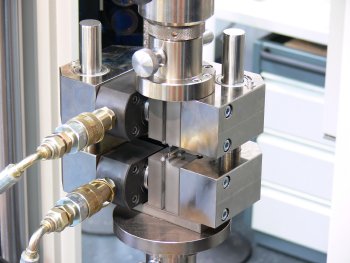Zwick/Roell AG, the worldwide leader in intelligent testing of materials and components, will be displaying the innovative Hydraulic Composite Compression Fixture (HCCF) test device at JEC Europe 2012, the premier exhibition for composites to be held here March 27-29.
The HCCF test device is designed for the testing of carbon fiber reinforced plastics and glass fiber reinforced plastics with unidirectional fiber reinforcement.
 Zwick's Hydraulic Composite Compression Fixture (HCCF) test device.
Zwick's Hydraulic Composite Compression Fixture (HCCF) test device.
"The features of this fixture are designed to reduce variances in test results and enhance test throughput," said Helmut Fahrenholz, manager, plastics at Zwick/Roell AG in Ulm Germany.
Tested and approved by Airbus, the HCCF test device meets the requirements of the company's test standard AITM 1.0008 edition 2010, which describes both shear loading and combined loading. The HCCF test device also meets the requirements for a mechanical testing tool outlined in global testing standards ASTM D 6641 and ISO 14126, procedure 2.
Due to the directional and shearing sensitivity of fiber-based composites, test forces must be precisely applied in the intended direction. As a result, specimen alignment is a crucial factor in achieving accurate results. To measure the alignment, Zwick uses special measuring devices which orient themselves to the shape and dimensions of the specimen. The tensile axes of the testing machine are oriented using mechanical alignment fixtures.
Traditional test fixtures can be operator-unfriendly with various obstructions in access to the specimen for strain measurement, Fahrenholz said.
"With traditional test fixtures, the number of faulty tests in which excessive specimen flexure occurs is relatively high and accordingly the tests can be time consuming," he said.
Using the HCCF test device, specimen alignment and mechanical set-up is facilitated by a friction free and precise guidance system. An open C-frame facilitates the loading of specimens and allows for easy attachment of extensometers. Hydraulically operated specimen grips provide reliable and reproducible clamping of the specimen.
A parallel-closing hydraulic clamping arrangement with flat jaws aligned exactly with each other offers several advantages including ease of access to the specimen, simplification of the clamping procedure and the elimination of wedge movements which could amplify any bending moments occurring during the test, said Fahrenholz.
The fixture is also suitable for the following testing standards: prEN 2850, DIN EN ISO14126, DIN 65380 and QVA-Z10-46-38.